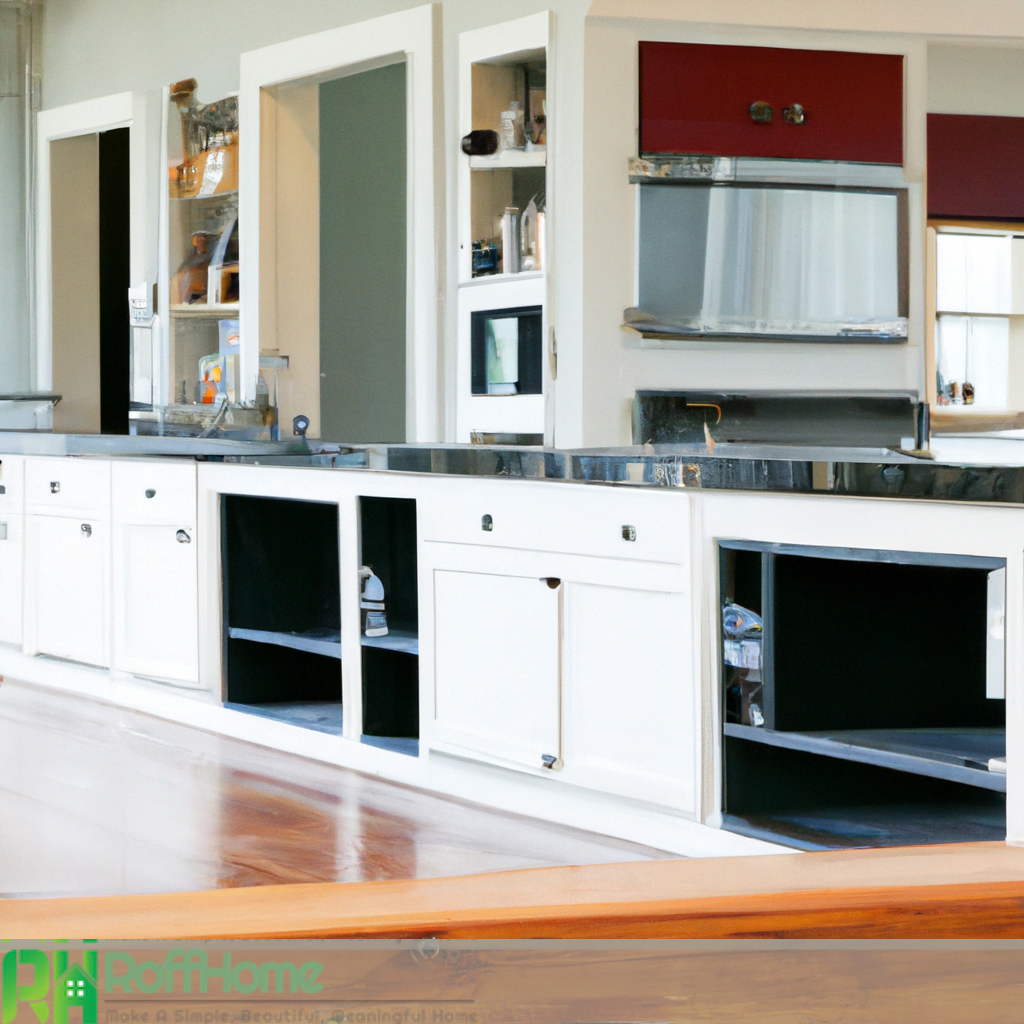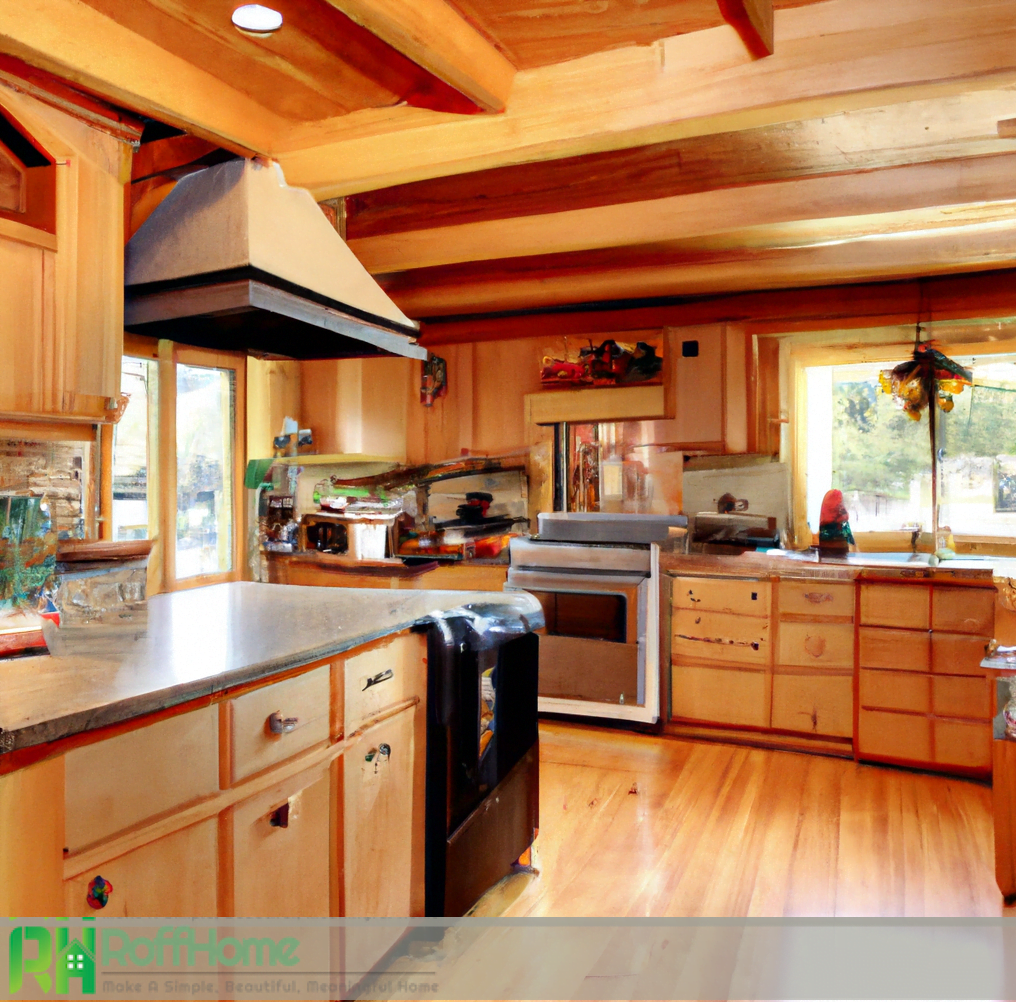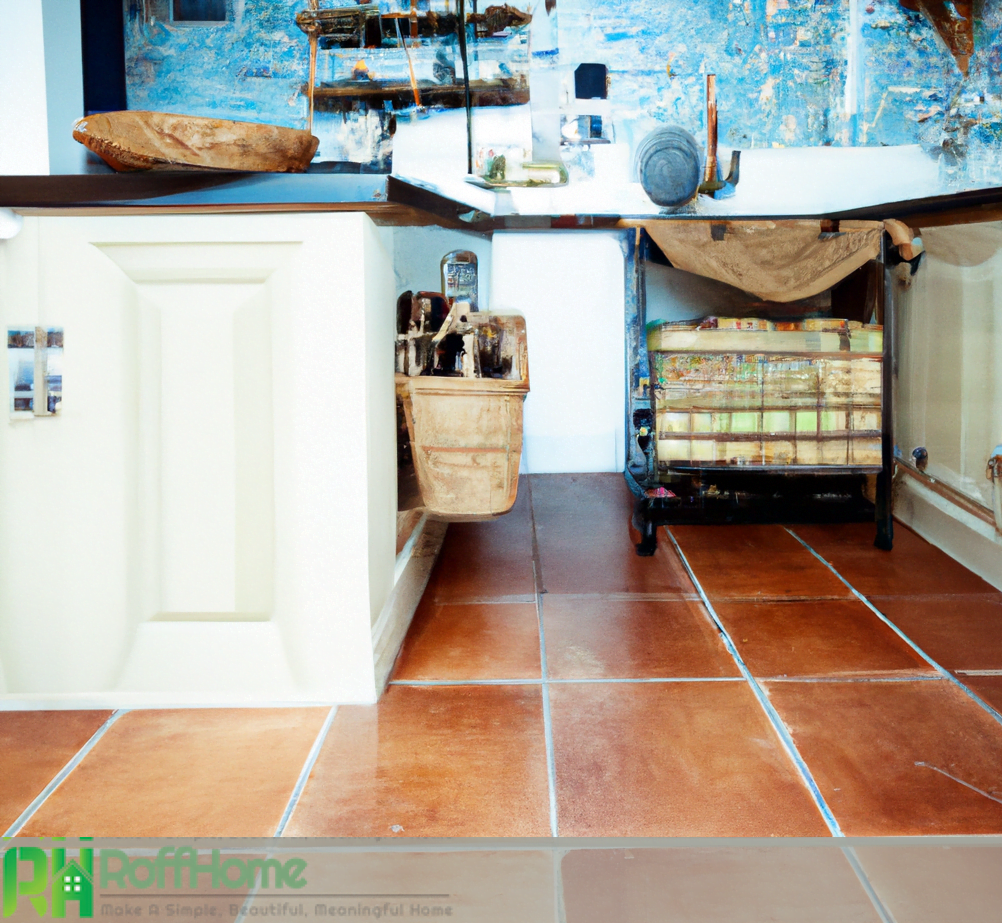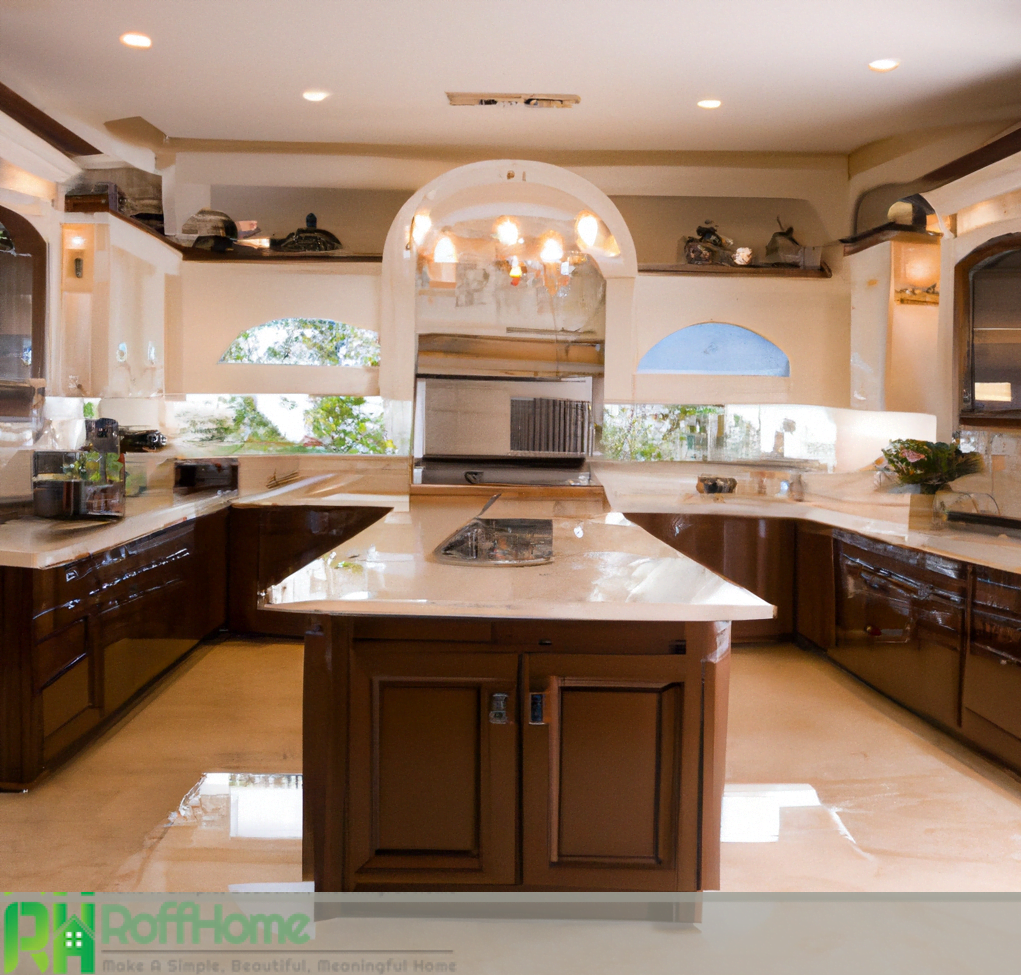Elevate Your Kitchen with a Black Tile Floor Design | Tips & Inspiration

A kitchen with black tile flooring is a bold and stylish choice for homeowners who want to create a unique and modern space. Black tiles offer a sleek and sophisticated look that can complement various design styles, from minimalist to traditional. They are also incredibly durable and easy to clean, making them ideal for high-traffic areas like the kitchen.
One of the benefits of using black tile flooring in the kitchen is its versatility in decorating options. Black is a neutral color that can be paired with various colors and textures to create a customized look. Different color schemes can create moods and styles, from a dramatic, bold look to a more serene and calming atmosphere.
However, it is important to consider the maintenance and cleaning of tile flooring, as it can show dirt and dust more easily than lighter-colored flooring. The kitchen layout, choice of appliances, backsplash, countertops, cabinetry, hardware, sink, faucet, and ventilation also create an overall cohesive and functional space.
The history and evolution of black tile flooring in kitchens
Black tile flooring has been a popular choice for kitchen flooring for many years, with its origins tracing back to ancient civilizations such as the Greeks and Romans. Back then, black tiles were made from natural stone, such as slate or granite, and were often used in public spaces such as courtyards and temples.
In the 19th century, black tiles became more widely used in homes, particularly in the kitchen. This was due to the development of new tile-making techniques, which made them more affordable and accessible to the general public. Black tiles were particularly popular in Victorian homes, often paired with white or cream cabinetry and decorative accents.
The popularity of tile flooring continued into the 20th century, with the rise of modernist design in the 1920s and 30s. Black tiles were used in many modernist homes, whose sleek and sophisticated look complemented the era’s clean lines and minimalistic design.
In the latter half of the 20th century, tile flooring became popular for kitchen flooring, particularly in homes with a more contemporary or industrial style. Advances in tile-making technology meant that black tiles could be made from various materials, such as ceramic or porcelain, making them even more durable and long-lasting.
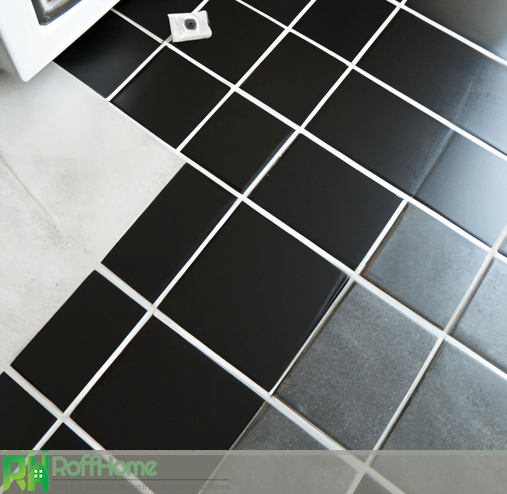
10 Design Ideas for a Kitchen with Black Tile Floors
Designing a kitchen with tile floors offers a variety of creative opportunities to make the space feel stylish and modern. Here are ten design ideas to help you make the most of your kitchen:
Bold color schemes: Black tiles can be paired with bold colors to create a dramatic and eye-catching kitchen. Colors like red, blue, or green can be used for accent walls, cabinetry, or decorative accessories.
Natural elements: Incorporating natural materials like wood or stone can add warmth and balance to a kitchen with tile floors. This can be done using wooden cabinetry, stone countertops, or natural fiber rugs.
Minimalist design: The tile floors can create a sleek and minimalist kitchen. This can be achieved through simple cabinetry, minimalist hardware, and clean lines throughout the space.
Metallic accents: Black tiles pair well with metallic finishes like brass or copper. Adding metallic accents to the kitchen can create a sophisticated and glamorous look.
Lighting: Good lighting is essential for a kitchen with tile floors. Natural light can help brighten the space, while pendant or track lighting can provide task lighting and create a focal point.
Statement backsplash: A statement backsplash can add interest and texture to a kitchen with tile floors. Options like subway or patterned tiles can create a striking and unique look.
Open shelving: Open shelving can create a sense of openness and airiness in a kitchen with tile floors. Displaying decorative objects or kitchenware can add color and personality to the space.
Artwork: Artwork can add color and interest to a kitchen with tile floors. A bold and colorful painting or print can make a statement and create a focal point in the space.
Contrast: Black tiles can create contrast with lighter elements like white cabinetry or countertops. This can create a striking and dynamic look in the kitchen.
Plants: Adding plants to a kitchen with tile floors can create a natural and organic feel. Plants like herbs or succulents can be displayed on windowsills or countertops to add color and texture to the space.
Design tips for incorporating black tile flooring into various kitchen styles
Black tile flooring is a versatile option that can work well with various kitchen styles, from traditional to modern. Here are some design tips for incorporating tile flooring into different kitchen styles:
Traditional kitchens: In traditional kitchens, tile flooring can be paired with classic design elements like wood cabinetry, stone countertops, and decorative molding. The use of warm colors and natural materials can help balance out the tiles’ darkness.
Modern kitchens:The tile flooring can create a sleek and modern look in the kitchen. Pairing black tiles with minimalist cabinetry, stainless steel appliances, and clean lines can create a contemporary vibe.
Farmhouse kitchens: The tile flooring can be incorporated into farmhouse kitchens by pairing them with rustic elements like reclaimed wood shelving, shiplap walls, and farmhouse sinks. Natural textures like jute or linen can create a cozy and inviting feel.
Industrial kitchens: In industrial kitchens, The tile flooring can be paired with raw materials like concrete, exposed brick, and metal accents. Adding industrial-style lighting fixtures can further enhance the look.
Coastal kitchens: The tile flooring can be incorporated into coastal kitchens by pairing them with light and airy design elements like white cabinetry, natural wood accents, and sea-inspired decors like seashells and driftwood.
Scandinavian kitchens: In Scandinavian kitchens, tile flooring can be paired with light wood cabinetry, white walls, and minimalist design elements like pendant lighting and clean lines. Adding natural elements like plants and wood accents can create warmth and balance.
Bohemian kitchens: The tile flooring can be incorporated into bohemian kitchens by pairing them with colorful and eclectic design elements like patterned rugs, colorful tile backsplashes, and eclectic lighting fixtures. The addition of plants and natural elements can create a cozy and inviting feel.
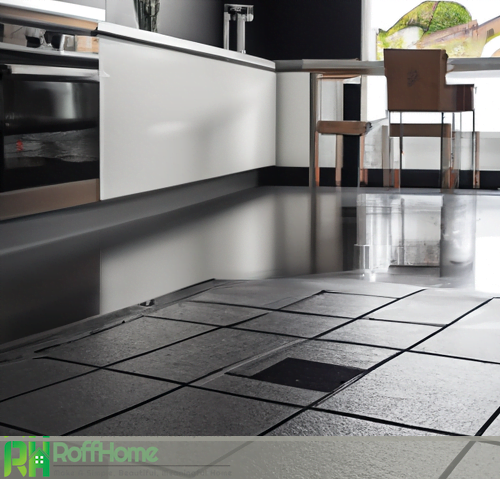
How to decorate a kitchen with black tile flooring
Decorating a kitchen with tile flooring can seem challenging, but it offers many creative opportunities to create a stylish and modern space. Here are some tips on how to decorate a kitchen:
Choose a color scheme: The tile flooring can be paired with a wide range of colors to create a striking and stylish look. Consider white, gray, and navy blue or bright colors like red or yellow.
Add natural elements: Incorporating natural materials like wood or stone can add warmth and balance to a kitchen with tile flooring. This can be done using wooden cabinetry, stone countertops, or natural fiber rugs.
Lighting: Good lighting is essential for a kitchen with tile flooring. Natural light can help brighten the space, while pendant or track lighting can provide task lighting and create a focal point.
Create contrast: To avoid a monotone look, incorporate lighter elements like white cabinetry or countertops. This can create a dynamic and interesting look in the kitchen.
Add texture: The tile flooring can sometimes appear flat and lifeless. Adding texture through patterned tile, textured wallpaper, or a textured backsplash can create interest and depth in the space.
Use bold accessories: A kitchen with tile flooring can provide a dramatic backdrop for bold accessories like colorful artwork, patterned curtains, or unique light fixtures. These accessories can add personality and style to the space.
Incorporate metallic finishes: Black tiles pair well with metallic finishes like brass or copper. Adding metallic accents to the kitchen can create a sophisticated and glamorous look.
Display decorative objects: Open shelving can be used to display decorative objects or kitchenware, adding color and personality to the space.
Creating a modern and minimalist kitchen with black tile flooring
Creating a modern and minimalist kitchen with tile flooring can be a great way to create a sleek and sophisticated look. Here are some tips for achieving a modern and minimalist look in a kitchen with tile flooring:
Please keep it simple: In a minimalist kitchen, less is more. Avoid clutter and excess decor; focus on clean lines and simple design elements.
Choose sleek cabinetry: Cabinets in a modern and minimalist kitchen should be sleek and simple. Choose cabinets with clean lines and minimal hardware to create a streamlined look.
Use a neutral color palette: Black flooring can create a bold statement, so keep the rest of the kitchen colors neutral. Use white or gray cabinetry and countertops to create a cohesive and minimalist look.
Incorporate natural materials: Natural materials like wood or stone can add warmth and balance to a minimalist kitchen. This can be done through wooden shelving, a natural wood countertop, or a stone backsplash.
Lighting: Good lighting is essential in a modern and minimalist kitchen. Add under-cabinet, pendant, or track lighting to create a focal point and add functionality.
Incorporate metallic finishes: Adding metallic finishes like stainless steel or brushed nickel can create a sleek and modern look in a kitchen with tile flooring.
Use open shelving: Open shelving can create a minimalist and modern kitchen look while providing a functional storage solution.
Create a focal point: In a minimalist kitchen, creating a focal point can add interest and personality to the space. Consider incorporating a unique light fixture or a bold piece of artwork.
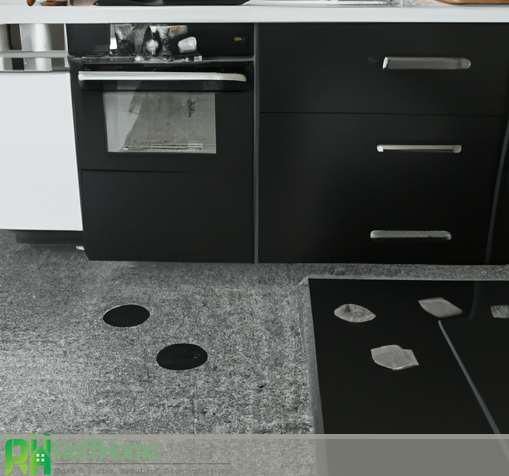
Installation of black tile flooring – tips and tricks
Installation of tile flooring can be challenging, but with the right tips and tricks, it can be done efficiently and effectively. Here are some tips for the installation :
Preparing the surface: Before installation, ensure the surface is clean, level, and free from debris or adhesive residue. It is important to use a good quality underlayment or subfloor to ensure the stability and durability of the flooring.
Choosing the right type of tile: When choosing black tiles for your flooring, consider factors such as size, texture, and finish. Large tiles can make the room more spacious, while textured tiles add interest and depth.
Choosing the right grout: The choice of grout can significantly impact the appearance and durability of the flooring. Consider using a darker-colored grout to help the tiles stand out and to avoid showing dirt and grime.
Cutting the tiles: When cutting the tiles, use a wet saw to prevent chipping and ensure a clean cut. Make sure to measure accurately and cut slowly to avoid mistakes.
Laying the tiles:
- Start laying the tiles in the center of the room and work outward.
- Use spacers to ensure consistent and even spacing between the tiles.
- Check the level frequently to avoid any unevenness in the flooring.
Sealing the grout: Once the tiles are laid and the grout is dry, seal the grout to prevent staining and moisture damage.
Maintaining the flooring: To maintain the appearance and durability of the tile flooring, clean it regularly with a neutral cleaner and avoid using abrasive or acidic cleaners.
Tips for cleaning and maintaining black tile flooring in the kitchen
Black tile flooring in the kitchen can create a stylish and sophisticated look, but it can also be challenging to clean and maintain. Here are some tips for cleaning and maintaining tile flooring in the kitchen:
Sweep and vacuum regularly: To prevent dirt and debris from scratching the tiles, sweep or vacuum the floor regularly.
Use a neutral cleaner: When cleaning the floor, use a neutral cleaner specifically designed for tile flooring. Avoid using harsh or abrasive cleaners that can damage the tiles.
Clean up spills immediately: To prevent stains and damage, clean up spills immediately. Use a damp cloth to thoroughly wipe up the spill and dry the area.
Use a soft-bristled brush: When cleaning the grout, use a soft-bristled brush to avoid scratching the tiles. Scrub the grout gently and rinse thoroughly with water.
Seal the grout: To prevent staining and moisture damage, seal the grout every 1-2 years. Make sure to clean the grout thoroughly before sealing it.
Avoid using acidic cleaners: Avoid using acidic cleaners, such as vinegar or lemon juice, on tile flooring. These cleaners can etch the tiles and cause damage.
Use rugs or mats: Place rugs or mats in high-traffic areas, such as in front of the sink or stove, to prevent wear and tear on the tiles.
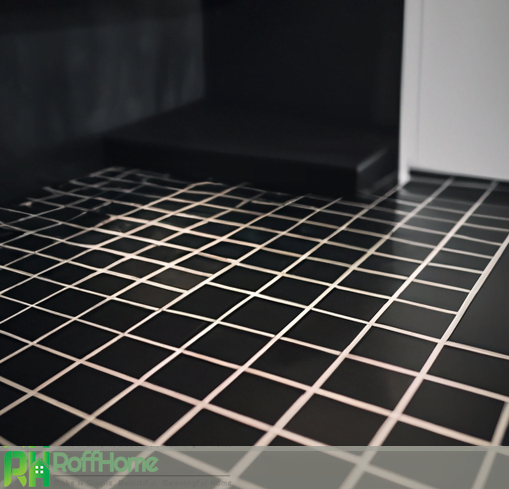
Pros and cons of using black tile flooring in the kitchen
Black tile flooring can add a stylish and sophisticated look to the kitchen, but there are also pros and cons to consider before deciding to install it. Here are some of the pros and cons of using :
Pros:
Aesthetically pleasing: The tile flooring can create a modern, elegant look often associated with high-end kitchens.
Timeless: The tile flooring is a classic design element that never goes out of style. It can add a sense of timelessness to the kitchen.
Durable:The tile flooring is made from durable materials that withstand heavy foot traffic, spills, and scratches.
Easy to clean: The tile flooring is relatively easy to clean and maintain, as it does not show dirt and stains as easily as lighter-colored flooring options.
Versatile: The tile flooring can be paired with various colors and styles to create a unique and personalized look.
Cons:
Shows dust and debris: While tile flooring is relatively easy to clean, it does tend to show dust and debris more easily than lighter-colored flooring options.
Can be difficult to match: Finding the right shade of black tile can be difficult, especially if you need to match it to existing design elements in the kitchen.
Can make the space look smaller: This can make a space appear smaller, especially if it is a smaller kitchen.
Requires more lighting: This can absorb light and make the kitchen appear darker, so additional lighting may be needed to brighten the space.
May not be suitable for all styles: While tile flooring can work well in modern and minimalist kitchens, it may not be suitable for all styles, such as traditional or rustic kitchens.
In conclusion, a kitchen with black tile flooring can create a stylish, sophisticated, timeless, and elegant look. While there are some challenges to consider, such as cleaning and maintenance, the benefits of tile flooring in the kitchen make it a popular choice for homeowners.

